Over the past 2 years I took these pictures while bicycling and hiking in Oregon’s national forests.
Cycling a Siuslaw National Forest gravel road — note the many down, green branches, which could have killed or injured me had I been underneath when they fell.
Downed trees littered the road, too. Lucky to have escaped unscathed!
I barely avoided this killer on the Deschutes National Forest last spring. Phew!
The Forest Service wants to log these dead trees because they threaten the visiting public along this highly used recreation road.
Although this decade-old landslide blocks visitor use, the Forest Service wants to log the dead trees (shown in the previous pic) beyond the slide because they are “hazardous.”
Forest Service “hazard tree specialist” said this big snag would have to come down because it is too dangerous. The FS never thought the snag dangerous enough to remove before a 2020 fire burned neighboring trees.
This one is sure to kill the unwary. Oops, this dead tree isn’t in a national forest at all. It threatens hikers along Eugene’s Ridgeline Trail, probably the most visited trail system in Lane County. The Ridgeline Trail has hundreds of recently-killed (drought) Douglas-fir trees within striking distance of the trail. Occasionally, they fall, sometimes across the trail. No one has died. No one is prophylactically cutting them down. Life goes on. Ho hum.
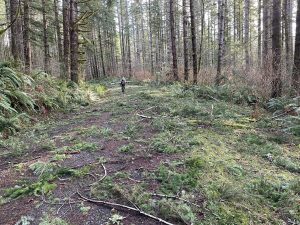
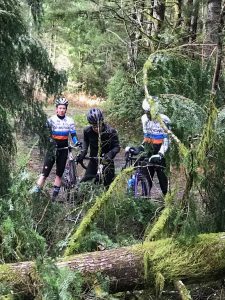
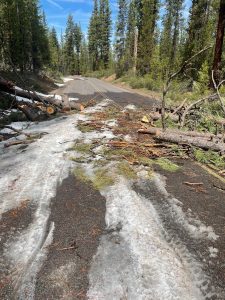
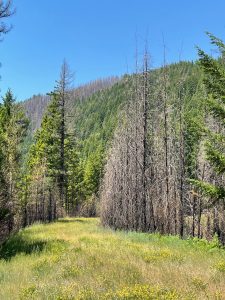

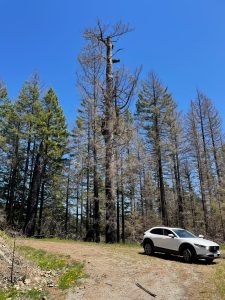
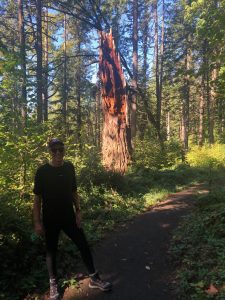
Andy, I’m glad you survived your time in the woods!
Hey Andy, was this post published before it was finished? Or is this satire? I mean how in the world is there any feasible way to make a forest “safe” from things falling down without destroying the forest? It’s like saying we’re going to make beaches safe from rip tides. It’s not going to happen.
Also once large diameter dead snags are barely 20 feet tall, their ability to fail and injure someone is highly unlikely. But again, based on your last post maybe this is satire?
As for the landslide surrounded by fire killed trees. Those trees will precipitate woody debris in each gust of wind for decades, which will help rapidly regrow the vegetation in a way that will stabilize that unstable area. But if you cut down all those dead trees the regrowth of vegetation on that landslide will be deprived of woody debris recruitment and resultant mycelia mats that boost healthy growth rates.
And as always, the forest need their dead, they provide countless benefits to the entire food chain as the majority of species depend on deadwood at some point in their lifespan.
I can also say to all the nervous nellies that once you spend a few decades around trees falling in wind storms or while trying to stop loggers from falling, it’s pretty easy to get out of the way if you’re paying close attention to all the noises and how and how much acceleration there is from start to finish. The notion that a tree is going to silently sneak up on you and kill you is not how it works. Of course if you’re traveling on a bike or in a car and don’t look up often and aren’t listening for warning signs…
Thanks Andy for pointing out that forests are VERY DANGEROUS places to visit!
I love the photo of a landslide that’s blocking road access to hazard trees and yet the agency still thinks they need to make it safe for the public.
My sense is that the salvage sale foresters with volume signs in their eyes and lawyers are driving the current FS thinking much more than common sense is!
Who has done a risk calculation re: the risk while driving to the National Forest? I know I’m much more at risk while driving a snowy highway to my fave XC ski trail than I am when I pass by a standing dead tree next to the trail.
The difference between “real” and “perceived” risk can be very big!
We know of course that there’s one sure way to make the NF’s much safer; clearcut and pave them! There won’t be anything left that might fall on unwary visitors!
I think the point of removing hazard trees from roads is not so much that they will fall down on top of people, but more that they will ultimately fall down and need to be cleared. So why not clear them all now with one contract? Not everyone carries a chainsaw in their vehicles.
Maybe this is the same thing Steve said.
ALL trees ultimately fall down. “So why not clear them all now with one contract?” Indeed :).
They are along roads. If we say two or one tree lengths (sure there are opportunities for agreement somewhere in here) and our best guess is that they will die and fall over within 10-20 years …that’s not “all” by any means. There are also two areas that folks could come to agreement… 1) how far and 2) how close to falling over. That’s why I’m thinking one idea would be a GTR.. round up the best available expert/science judgment as to both of those
https://www.nydailynews.com/news/national/family-sues-forest-service-tree-falls-son-article-1.1313492
How about we just shift all liabilities to Andy Stahl?
Perhaps if the law firms masquerading as forestry conservation “nonprofits” were less intransigent over foundational resource management, agencies would be less disingenuous when trying to satisfy the federal purposes for which millions of acres of lands were acquired.
Shaun — Oregon’s Recreational Use Statute immunizes me from liability:
ORS § 105.682 — Except as provided by subsection (2) of this section, and subject to the provisions of ORS 105.688, an owner of land is not liable in contract or tort for any personal injury, death or property damage that arises out of the use of the land for recreational purposes, gardening, woodcutting or the harvest of special forest products when the owner of land either directly or indirectly permits any person to use the land for recreational purposes, gardening, woodcutting or the harvest of special forest products. The limitation on liability provided by this section applies if the principal purpose for entry upon the land is for recreational purposes, gardening, woodcutting or the harvest of special forest products, and is not affected if the injury, death or damage occurs while the person entering land is engaging in activities other than the use of the land for recreational purposes, gardening, woodcutting or the harvest of special forest products.
You’re welcome.
Which doesn’t exempt liability for known hazards and negligence…you know, for such pesky things like dead trees that have a risk of falling on people.
Shaun, I don’t know where you get that idea. “Not liable in contract or tort for any personal injury, death or property damage” covers every tort, including torts resulting from negligence and known hazards. The law’s only exception is for “intentional injury,” e.g., if I put up hidden trip wires to ambush mountain bikers.
The snark is cute and all but I’d be willing to bet that any land manager who has had to console next-of-kin after a tree strike fatality finds this topic somewhat less humorous.
Public land managers should feel no more responsibility for a tree strike fatality than for an avalanche, rock-climbing, or swimming fatality. You may be part of a Nanny State, but you’re not my parent. Get over yourself.
Andy, “Public land managers should feel no more responsibility for a tree strike fatality than for an avalanche, rock-climbing, or swimming fatality.” YES! All of those. Do what you can to minimize any risk. Ask my friend the park manager.
You want to “minimize” risk from federal land trees? Cut them ALL down! That’ll save one life per year. Goodie gumdrops. Hope those park and forest managers feel the trade-off was worth it. While they are at it, why not close all federal lands to public use. That’ll save the other 99% of federal land fatalities that happen each year from hiking, mountain climbing, swimming. Good job managers! Well, except for the loggers needed to cut down all those pesky dangerous trees. We like them, so we’ll let them in.
“Get over yourself” is rich with irony coming from Armchair Andy, the keyboard crusader with all the answers. He’s lobbied for timber interests, spent a long few weeks working for the feds, and now claims to be a conservationist… but we all know that the only interest he ever really serves is his own ego. Notifying next of kin = a nanny state, huh? What should they do, leave the body face down under a log until someone comes by to claim it? Spare us your know-it-all nonsense.
No matter who are or who you work for, if you find a “body face down under a log,” contact the county sheriff immediately. If the person is deceased, leave the body where it is — do not disturb it. The body and the tree are a potential crime scene. If the person is alive, call 911 and provide medical assistance consistent with your skill level.
<>
Hate to break it to you but Comedian isn’t a viable option for your next career change. Clown, on the other hand …
Smokey Wire folks, let us please stick to facts and discussion of the issues, not ad hominem attacks, which gain us nothing.
Again, there is no need to keep the dead or dying trees that can hit roads, and other human improvements that could be damaged. Some popular trails need to have hazards removed, too. I’ve done a lot of these, and I’ve never had the loggers do something that wasn’t in the project documents. Yes, there are some things both parties can agree to, as long as they don’t conflict with the rules, laws and policies… and the timber sale contract. You might disagree with what constitutes a hazard but, Region 6 folks have, officially, had the hazard tree training.
Andy,
Thanks for proving the examples. I agree that most of these could and should be left standing.
But do you have any examples where cutting hazard tees is justified? Busy road, parking lot, power lines?
Power lines are a special case, as California’s recent wildfire experiences have proven. Every tree — dead or alive — is a hazard when it comes to power lines. I suspect most trees that fall into power lines are alive when they do so. Trees fall onto power lines with catastrophic results when high winds blow them over. That’s why California utilities now turn off power prophylactically when a service area is forecast for high winds. The extraordinarily bad consequences of power line-ignited fires, when high wind blows trees into lines during drought conditions, counsel for keeping power line right-of-ways clear of all trees. For power lines, it’s not tree condition that matters; it’s tree proximity to power lines combined with the inescapable fact-of-physics that all trees fall over.
As for trees in other places, it’s like real estate: location, location, location. The fallacy, however, is that dead or damaged trees are quantitatively more hazardous than are live trees. No one has ever shown that to be the case with real data. However, an entire industry of tree surgeons and arborists relies on the commonly-held belief that tree failure is predictable. It’s not.